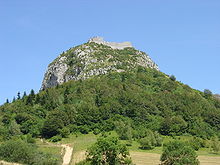|
Château de Montségur
The Château de Montségur (English: Castle of Montsegur; Languedocien: Castèl de Montsegur) is a former fortress near Montségur, a commune in the Ariège department in southern France. Its ruins are the site of a razed stronghold of the Cathars. The present fortress on the site, though described as one of the "Cathar castles," is actually of a later period. It has been listed as a monument historique by the French Ministry of Culture since 1862.[1] GeographyThe ruins of Montségur are perched at a precarious 1,200 metres (3,900 ft) altitude in the south of France near the Pyrenees. Located in the heart of France's Languedoc-Occitanie regions, 80 km (50 mi) southwest of Carcassonne, Montségur dominates a rock formation known as a pog — a term derived from the Languedocien dialect of Occitan — puòg or puèg, meaning "peak, hill, mountain." The top of the ruin is reached by a path and is 170 m above the road. HistoryThe earliest signs of human settlement in the area date back to the Stone Age. Evidence of Roman occupation such as Roman currency and tools have also been found in and around the site. The name comes from Latin mons securus, which evolved into mont ségur in Occitan, which means "safe hill". In the Middle Ages the Montsegur region was ruled by the Counts of Toulouse, the Viscounts of Carcassonne and finally the Counts of Foix. Little is known about the fortification until the time of the Albigensian Crusade. Cathar castleIn about 1204, Raymond de Péreille, one of the two lords of Montségur, the other being his cousin Pierre-Roger de Mirepoix, decided to rebuild the castle that had been in ruins for 40 years or more.[2] Refortified, the castle became a center of Cathar activities, and home to Guilhabert de Castres, a Cathar theologian and bishop. In 1233 the site became "the seat and head" (domicilium et caput) of the Cathar church.[2] It has been estimated that the fortified site housed about 500 people when in 1241, Raymond VII besieged Montsegur without success.[3] The murder of representatives of the inquisition by about fifty men from Montsegur and faidits at Avignonet, on 28 May 1242, was the trigger for the final military expedition to conquer the castle, the siege of Montségur. In 1242 Hugues de Arcis led the military command of about 10,000 royal troops against the castle that was held by about 100 fighters and was home to 211 Perfects (who were pacifists and did not fight) and civilian refugees.[2] The siege lasted nine months, until in March 1244, the castle finally surrendered. Approximately 220 Cathars were burned en masse in a bonfire at the foot of the pog when they refused to renounce their faith. Some 25 actually took the ultimate Cathar vow of consolamentum perfecti in the two weeks before the final surrender. Those who renounced the Cathar faith were allowed to leave and the castle itself was destroyed. In the days prior to the fall of the fortress, several Cathars allegedly slipped through the besiegers' lines. This led to legends that they escaped with a secret treasure or esoteric knowledge. In 1906, esoteric French writer Joséphin Péladan proposed that the treasure was really the Holy Grail, arguing that Montségur was the Munsalväsche (or Montsalvat) of Wolfram von Eschenbach's 13th-century Grail romance Parzival. This idea was followed and expanded upon by various later writers, especially in France, and has inspired legends, conspiracy theories, and fictional works associating the Cathars and Montségur with the Holy Grail.[4] The later fortress The present fortress ruin at Montségur is not from the Cathar era. The original Cathar fortress of Montségur was entirely pulled down by the victorious royal forces after its capture in 1244. It was gradually rebuilt and upgraded over the next three centuries by royal forces. The current ruin so dramatically occupying the site, and featured in illustrations, is referred to by French archeologists as "Montsegur III" and is typical of post-medieval royal French defensive architecture of the 17th century. It is not "Montsegur II," the structure in which the Cathars lived and were besieged, of which few traces remain today.  Montségur's solar alignment characteristics, visible on the morning of the summer solstice in particular, are part of what set this castle apart as an architectural wonder. This often mentioned solar phenomenon, occurring in an alignment of two windows in the fortress wall, has been observed by hundreds of students, astronomers, spiritual pilgrims and locals alike who come to the chateau specifically to view it every year and has been recorded and included in the documentary "The Otherworld," (by Richard Stanley) in 2013.  The Groupe de Recherches Archéologiques de Montségur et Environs (GRAME) (Archeological Research Group of Montsegur and Vicinity), which conducted a 13-year archeological excavation of Montségur with minimal funds and the technology available at the time in 1964–76, concluded in its final report, which was not widely published, is not viewed as solid archeological research, and is hotly disputed by many, that:
This small quote is all that can be found of this study, and no other study has been done. Despite its questionable veracity and ethics, it has been repeated and quoted in virtually every document to be found on the subject.[citation needed] The small ruins of the terraced dwellings, immediately outside the perimeter of the current fortress walls on the north-eastern flank are, however, confirmed to be traces of authentic former Cathar habitations.[citation needed] GalleryMedia
See also
References
External linksWikimedia Commons has media related to Château de Montségur.
|
||||||||||||||||||||









